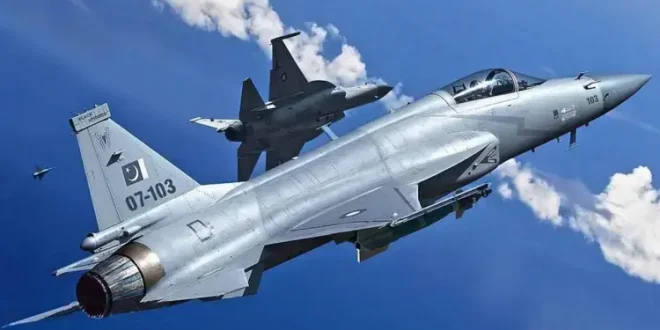Date: June 11, 2025 | By: Adnan Zaheer
In the early hours of May 7, a fierce aerial engagement reportedly took place between Pakistan and India. According to the Pakistan Air Force (PAF), it successfully shot down six Indian fighter jets—including a state-of-the-art Rafale—during this high-stakes dogfight. India, however, has neither confirmed nor denied these claims.
Interestingly, Indian Air Force spokesperson Air Marshal A.K. Bharti publicly stated that he would not comment on the loss of Indian aircraft because acknowledging it at this point would “benefit Pakistan.” Read between the lines, and this statement subtly suggests that something did, in fact, happen.
Understanding the Nature of Aerial Dogfights
One important aspect of air combat is that if an enemy aircraft is downed on your own territory—as was the case with Abhinandan in 2019—you don’t need further proof. But if it crashes on enemy soil, hard evidence becomes difficult to obtain, as seen in this latest conflict.
This leads to a crucial question: Why is Pakistan standing firm on its claim of downing not just one or two, but six Indian aircraft? And more importantly, in the absence of physical wreckage or Indian confirmation, how credible is this assertion?
To find the answer, our team at NewsMakers dug deep into both open-source intelligence and expert opinions.
What Does the Open-Source Data Say?
Reputable international outlets like The Washington Post and Reuters have already reported—based on open-source intelligence and U.S. officials—that at least two French-built Indian jets may have been destroyed during the Pakistani strikes. While these are credible reports, we wanted to break down the scientific methods that could potentially verify what really happened on the night of May 6-7.
How Can Jet Crashes Be Verified Scientifically?
According to Andrew Davidson, a former U.S. military official now with Geopolitical Futures, such incidents can be confirmed through open-source intelligence (OSINT). Experts analyze radar tracking data, satellite imagery, and electronic signatures to identify whether a jet has been potentially shot down.
Electronic Evidence: The PAF’s Explanation
At a recent press briefing, PAF’s Air Vice Marshal Aurangzeb Ahmed stated that electronic IDs were used to track and identify the exact locations where Indian aircraft were shot down. He gave precise coordinates:
- A MiG-29 was downed eight nautical miles from the Line of Control (LoC) near Srinagar.
- An SU-30 was hit 25 nautical miles from the LoC, also near Srinagar.
- One Rafale was downed 53 nautical miles from the LoC near Srinagar.
- A second Rafale was hit seven nautical miles from the international border near Bhatinda.
- A third Rafale was targeted near Jammu.
He explained that in modern warfare, “You can’t just imagine things. Every aircraft has an electronic ID, and with data links and radar systems, it’s impossible to hide once you’re detected.”
Why Is Pakistan So Confident?
Adding to this, retired Air Commodore Khalid Chishti told BBC Urdu that Pakistan’s Chinese-made JF-17 Thunder and J-10C fighters are equipped with PL-15 missiles, which have a range of about 200 km. These missiles transmit an electronic signal back to the fighter jet just before hitting the target. If the missile determines that it won’t strike its target, it self-destructs mid-air.
This built-in feedback system informs the pilot whether the target was hit or missed—even if the enemy aircraft is not visually observable.
Air Marshal (Retd.) Javed Ahmed, President of the Centre for Aerospace and Security Studies, emphasized that in modern combat, electronic signals serve as the most reliable proof. Every jet—be it Rafale, MiG-29, or SU-30—emits a unique electronic signature. When those signals suddenly disappear, it’s a clear indicator that the aircraft was successfully engaged.
Can Electronic Signatures Be Trusted?
When asked whether electronic signatures can definitively confirm a kill, Andrew Davidson explained: “These signals include radar frequencies, radio transmissions, and transponder codes. If these vanish mid-flight, it’s generally assumed the aircraft was taken down.”
He added that in conflicts between India and Pakistan, old and misleading videos often circulate online. However, metadata analysis and artificial intelligence tools can help distinguish between genuine and outdated footage.
It’s worth noting that BBC Verify confirmed the authenticity of three videos showing wreckage allegedly from French-made Rafale jets. The Washington Post independently verified the same visuals.
Final Thoughts
So, what really happened on the night of May 6–7?
We’ve presented the facts as fairly and honestly as possible—backed by intelligence, expert testimony, and independent verification. The evidence, though circumstantial, is increasingly difficult to ignore.
Now the decision is yours: Who’s telling the truth—Pakistan or India?




